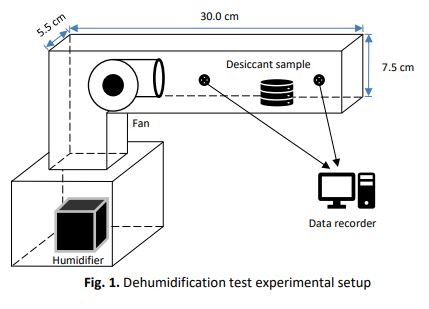Performance of Calcium Chloride and Silica Gel as Solid Desiccant Dehumidifiers for Indoor Air Quality
DOI:
https://doi.org/10.37934/arfmts.88.3.5770Keywords:
Calcium chloride, silica gel, solid desiccant, performance analysis, dehumidificationAbstract
Desiccant materials are recently discovered as a viable alternative in dehumidification technology due to their naturally hygroscopic qualities and minimal energy requirement. This paper discusses the performance of four brand samples of selected desiccants used for dehumidification. In this study, dehumidification ability and indoor air quality (IAQ) tests were carried out. The dehumidification ability test was conducted in a controlled environmental chamber at a temperature of 25°C, relative humidity of 70%, and air velocity of 2 m/s for 45-minute session. Meanwhile, the IAQ test was carried out in a naturally ventilated test room, and six IAQ parameters (relative humidity, air velocity, air temperature, particulate matter (PM10), airborne bacteria and carbon dioxide (CO2) were studied. The IAQ test was performed for five different conditions: control, application of brand samples A, B, C and D in the test room. From this study, it was found, brand A (0.6823 g/kg) and brand B (0.6849 g/kg) had a relatively good dehumidification ability during the 45-minute dehumidification ability test compared to brand C (0.3108 g/kg) and brand D (0.3982 g/kg). The IAQ test revealed that brand A had the biggest variation in indoor-outdoor relative humidity of 13.12%, while brand D had the smallest difference of 11.83%. Brand B had the highest average PM10 concentration of 0.037 μg/m3. The airborne bacterial count for all conditions had no statistical significance, indicating the application of desiccants were not effective in reducing airborne bacteria. From this study, it can be concluded that calcium chloride (brand A and B) samples performed better than silica gel (brand C and D) samples in terms of dehumidification ability and IAQ profile.
Downloads
































